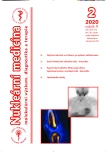Bone infarction as an accidental finding - a case report
Authors:
Martina Pešatová 1; Karolina Kašparová 2
Authors‘ workplace:
Prague Medical Care Department, s. r. o. – oddělení nukleární medicíny
1; Centrum klinické onkologie, AntiCa s. r. o., Kladno, ČR
2
Published in:
NuklMed 2020;9:26-29
Category:
Casuistry
Overview
Aim: Presentation of an incidental finding on bone scan indicated within a staging of oncological disease.
Case report: Case report: 73-year-old female patient was refered for a bone scan to exclude generalization of breast cancer. The examination did not reveal a metastatic proces but a high focal accumulation of a radiofarmaceutical in the femur and tibia near the left knee joint was visible. Osteomyelitis, fibrous bone dysplasia, or tumorous affection were considered at the differential diagnosis. Targeted SPECT/low-dose CT displayed increased accumulation of radiofarmaceutical at scintigraphic image, which contoured marrow cavity in distal metadiaphysis of the femur and proximal tibia. In addition, LDCT showed thickened corticalis of the dorsal part of the left femur. The differential diagnosis was thus extended by a bone infarction and aneurysmal bone cyst. The history connected with the left lower limb was negative. Etiology of these bone affections based on our examinations was ambiguous, we recommended targeted radiological investigation. At the oncologist-indicated CT, the lesions showed signs of a bone infarction.
Conclusion: Our case report confirms the importance of performing targeted SPEC/CT according to findings on bone scans and correlation with other examinations possibly radiological imaging methods.
Keywords:
SPECT/CT – bone infarction – incidental finding
Sources
- Wong B. Bone infarction [online]. [cit. 2020-04-23]. Dostupné z: https://briansradiologylearningdiary.wordpress.com/2018/01/16/bone-infarction/
- Fondi C, Franchi A. Definition of bone necrosis by the pathologist. Clin Cases Miner Bone Metab. 2007;4:21-26
- Rasuli B, Dixon A. Bone infarction [online]. [cit. 2020-04-23]. Dostupné z: https://radiopaedia.org/articles/bone-infarction-1
- Khan AN. Osteonecrosis (Bone Infarction) Imaging [online]. [cit. 2020-04-23]. Dostupné z: https://emedicine.medscape.com/article/387545-overview
- Bahndorf K, Pope TL, Imhof H et al. Musculoskeletal Imaging: A Concise Multimodality Approach. 1th edition. New York: Thieme, 2001, str. 228-230
- Rousková V, Lang O. Kostní infarkt imitující osteosarkom jako náhodný nález – kazuistika. NuklMed 2018;7:32-35
- Velasco BT, Ye MY, Chien B et al. Prevalence of Incidental Benign and Malignant Lesions on Radiographs Ordered by Orthopaedic Surgeons. J Am Acad Orthop Surg. 2020;28:356-362
- Greyson ND, Kassel EE. Serial bone-scan changes in recurrent bone infarction. J Nucl Med. 1976;17:184-186
- Mettler FA, Guiberteau MJ. Essentials of Nuclear Medicine and Molecular Imaging. 7th edition. Philadelphia: Elsevier, 2018, str. 243-256
- Van der Woude HJ, Smithuis R. Bone - sclerotic tumors and tumor-like lesions [online]. [cit. 2020-04-24]. Dostupné z: https://radiologyassistant.nl/musculoskeletal/bone-sclerotic-tumors-and-tumor-like-lesions
- Szatkowski J. Bone infarct. [online]. [cit. 2020-04-25]. Dostupné z: https://www.orthobullets.com/pathology/8078/bone-infarct
- Murphey MD, Foreman KL, Klassen-Fischer MK et al. From the Radiologic Pathology Archives Imaging of Osteonecrosis: Radiologic-Pathologic Correlation [online]. [cit. 2020-04-25]. Dostupné z: https://pubs.rsna.org/doi/10.1148/rg.344140019
Labels
Nuclear medicine Radiodiagnostics RadiotherapyArticle was published in
Nuclear Medicine

2020 Issue 2
Most read in this issue
- Bone infarction as an accidental finding - a case report
- Hyperfunctioning parathyroid gland as a cause of hyperparathyroidism and osteodystrophy – a case report
- Treatment of thyroid cancers with 131I
- Residual activity in the syringe after radiopharmaceutical injection
